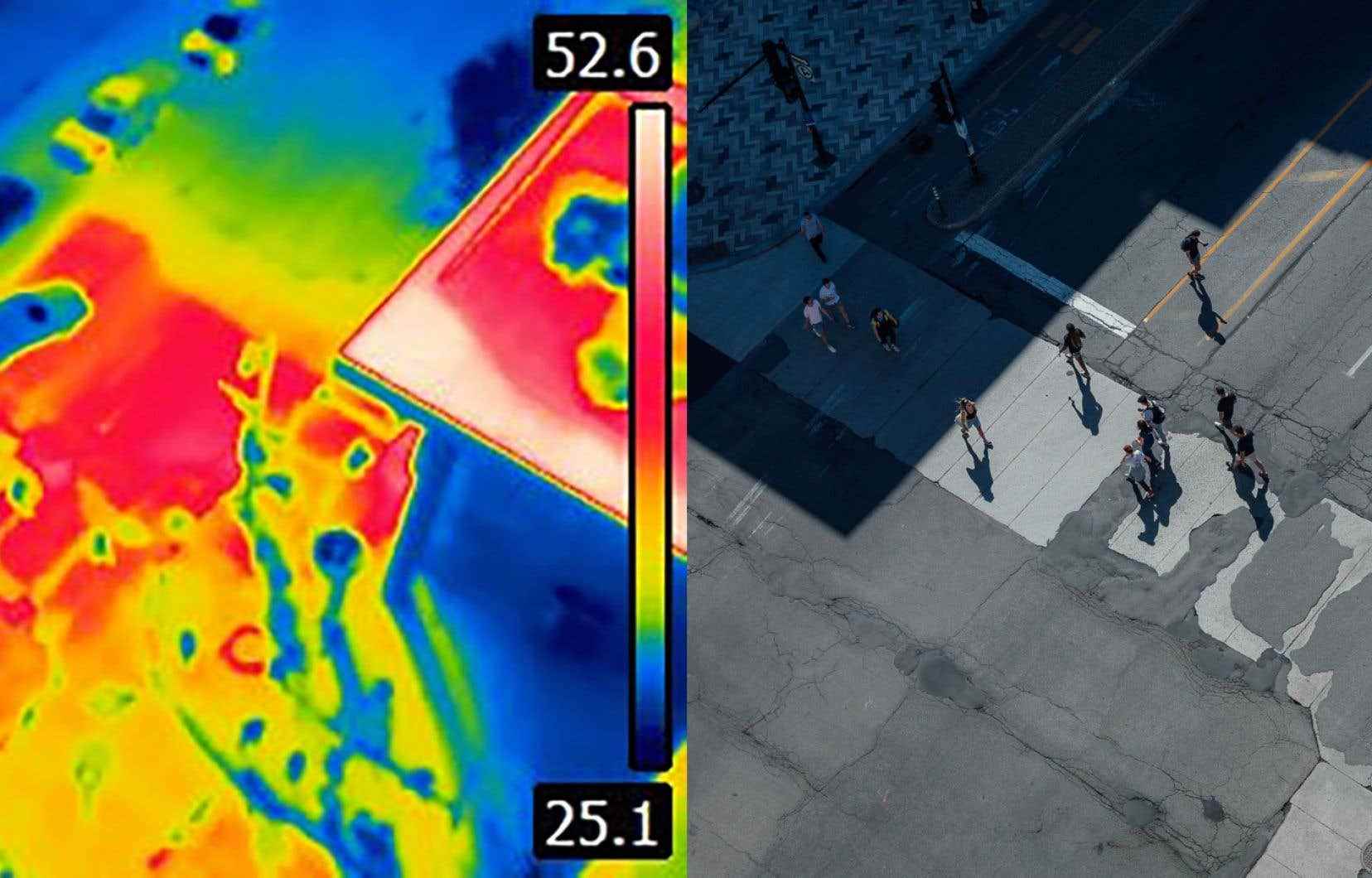Invisible, the heat? It all depends on how you look. These images, captured at different locations in Montreal with an infrared camera, show how our urban developments can make heat waves even more unbearable, or on the contrary reduce them. By Alexis Riopel and Valerian Mazataud.
A matter of reflection
The first phenomenon to take into account is the albedo, that is to say the reflective power of surfaces. Dark surfaces absorb the sun’s radiation (low albedo) and light ones reflect it (high albedo).
By heating, the materials themselves emit radiation. In the temperature range that interests us, it is infrared radiation. The measurement of this radiation by the camera makes it possible to deduce the temperature of the objects.
However, these objects can also reflect infrared light from the surroundings. As in the optical field, smooth surfaces — such as glass, metal or mirrors — are particularly reflective.
Influenced by these parasitic reflections, the temperature readings of infrared cameras are therefore not perfect. Despite this, they can give a good idea of where the heat is hiding.
A matter of materials
It was around 25°C in Montreal when this image was taken. Compared to the pavement, the white lines were several degrees cooler. By placing the hand on the ground, the difference was easily felt.
Parking lots are a major contributor to urban heat islands. Black bitumen, a material with very low albedo and of which asphalt is partly composed, can reach 80°C in summer.
“The best way to avoid heat islands is to prevent heat from entering the materials,” explains Michel Vaillancourt, a professor of civil engineering at ETS who is interested in the thermal properties of coatings. road.
The choice of aggregates in the asphalt or the application of white paint can make the pavement paler. Some foundation materials can enhance the evacuation of heat to the basement.
Although promising, these solutions “will not be applied on a large scale, but rather on an ad hoc basis” because of the costs, warns Mr. Vaillancourt.
A matter of convection
If we fail to block the absorption of solar radiation, the materials begin to store heat. They then release it during the night, which does not leave time for the quarters to cool off.
Humans experience ground heat in different ways. First, they bathe in the air heated by the ground (convection). Then they absorb infrared radiation from the surface (radiation).
Our perception of heat would depend approximately equally on convection and radiation.
In addition to making us feel heat from the ground, convection and radiation, along with evaporation, are the pathways by which urban environments evacuate their heat energy.
According to a study published in 2014 in the journal Natureconvection would also play a particularly important role in the formation of heat islands.
Indeed, it increases when the wind rubs on the roughness of the ground and becomes turbulent. The lack of roughness in cities—compared to forests, for example—would largely explain the concentration of heat in cities in temperate climates.
A matter of human activities
Heat accumulation also comes from human activities.
“Each automobile generates heat in the city,” explains Céline Campagna, researcher on climate issues at the National Institute of Public Health of Quebec (INSPQ).
As seen in this image, vehicle exhausts are hot. The wheels, heated by mechanics and friction on the ground, are also very hot.
According to a study carried out in Manchester, car traffic generates a third of the heat of anthropogenic origin in the city. The rest comes mainly from buildings.
Making a major shift towards active and public transport therefore made it possible to reduce parking needs, but also to reduce heat emissions from vehicles, argues Ms.me Campaigned.
Air conditioners also radiate heat into neighborhoods. At night, they can increase the outside temperature by 1°C. This is why experts do not recommend installing them en masse to adapt to the climate crisis.
A matter of vegetation
When there is a heat wave, not all neighborhoods are equal.
We see in this photo the Boulevard de l’Acadie which separates Parc-Extension, one of the most disadvantaged neighborhoods of Montreal, from the wealthy town of Mount Royal.
In thermal matters, the contrast between the two sectors is obvious. The many trees and greenery of the opulent residential area lower the ambient temperature by several degrees.
Vegetation acts in two ways. First, the evaporation of water from the leaves “consumes” heat. Then, their shade protects the ground from the sun.
Céline Campagna believes that cities must be massively greened. This must be done in all neighborhoods, otherwise the better off will flock to cooler areas and we will see “green gentrification”.
To keep residences cool, other strategies — such as using window shutters or improving insulation — can be combined advantageously with greening.
“There are all sorts of possibilities,” says the INSPQ researcher. The government just needs to be more directive in its requirements, rather than leaving it to the goodwill of promoters. »
